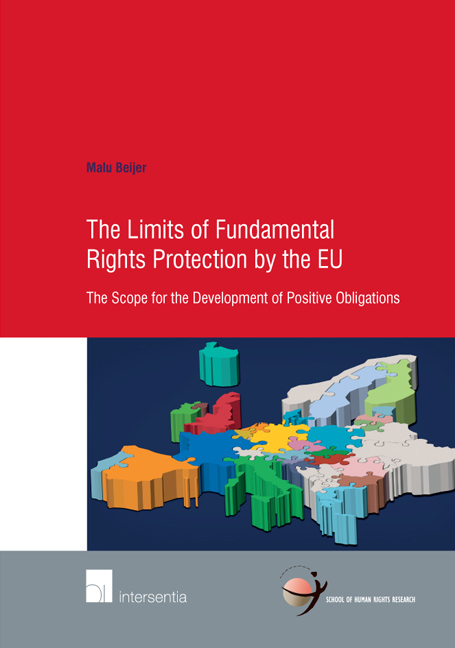 Limits of Fundamental Rights Protection by the EU
Limits of Fundamental Rights Protection by the EU from PART III - SYNTHESIS
Published online by Cambridge University Press: 27 September 2018
INTRODUCTION
This chapter aims to portray and further discuss the examples of positive obligations that are present in the case-law of the ECJ. Some of these examples have already been addressed in the discussions in part II. Here, an overview is given of these and other examples of positive obligations so that some further insight can be given into the kinds of positive obligations that can be recognised within the context of EU law. In addition, a selection of five case are reviewed further and assessed in light of the conclusions reached in part II on the scope of, and the limits on, the development of positive obligations under EU law (see chapter 10). This analysis aims to establish whether (if at all) the development of positive obligations by the ECJ raises conflict with the specific principles of EU law.
The following section first briefly explains how the distinction between the concepts of positive and negative obligations can be made within the context of EU law and for what specific reasons it is relevant to make this distinction (section 11.2.). Aft er that, an overview of the different examples of positive obligations from the case-law of the ECJ is given (section 11.3.). On the basis of this overview, the types of positive obligations that can so far be recognised within the current case-law of the ECJ are identified (section 11.4.). A further examination is then made of some specific judgments of the ECJ to find out whether or not the ECJ has overstepped the specific limits of EU law, or whether the approach adopted is too restrictive (section 11.5.). The chapter is rounded up by a conclusion (section 11.6.).
THE DISTINCTION BETWEEN POSITIVE AND NEGATIVE OBLIGATIONS WITHIN THE CONTEXT OF EU LAW
The ECtHR also has contrasted the recognition of negative obligations which, more traditionally, follow from the protection of fundamental rights, with the recognition of positive obligations. The ECtHR in principle adopts a different approach when examining whether states have complied with their negative or positive fundamental rights obligations.
To save this book to your Kindle, first ensure no-reply@cambridge.org is added to your Approved Personal Document E-mail List under your Personal Document Settings on the Manage Your Content and Devices page of your Amazon account. Then enter the ‘name’ part of your Kindle email address below. Find out more about saving to your Kindle.
Note you can select to save to either the @free.kindle.com or @kindle.com variations. ‘@free.kindle.com’ emails are free but can only be saved to your device when it is connected to wi-fi. ‘@kindle.com’ emails can be delivered even when you are not connected to wi-fi, but note that service fees apply.
Find out more about the Kindle Personal Document Service.
To save content items to your account, please confirm that you agree to abide by our usage policies. If this is the first time you use this feature, you will be asked to authorise Cambridge Core to connect with your account. Find out more about saving content to Dropbox.
To save content items to your account, please confirm that you agree to abide by our usage policies. If this is the first time you use this feature, you will be asked to authorise Cambridge Core to connect with your account. Find out more about saving content to Google Drive.